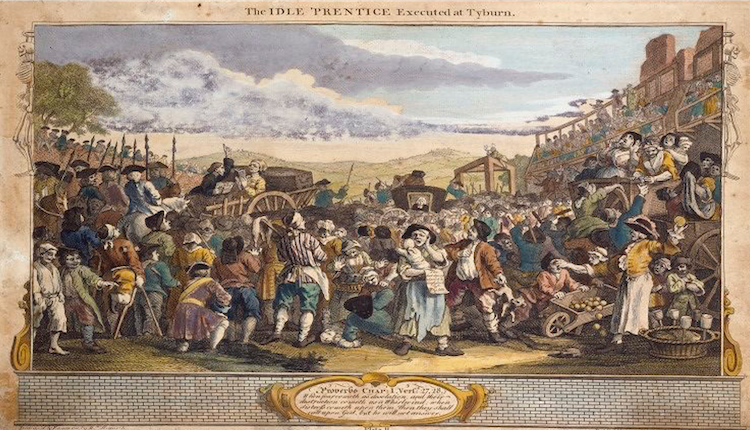Crime and Punishment is one of my favourite topics to teach at GCSE: it is exciting and horrifying.
It has great shock-value with its gruesome trials and bloody executions, and it also has contemporary relevance with its treatment of such issues as community values, law enforcement, and ‘modern’ crimes like drug and people trafficking.
However, Crime and Punishment is also, a tricky GCSE module. This is due to the nature of the exam skills and question stems that are attached to it.
The Edexcel ‘thematic study’ (Paper 1) requires students to engage with a range of historical concepts, including most prominently change and continuity. Although questions can also ask for an analysis of significance, causation and/or consequence.
Even the 4-mark similarity and difference question is harder than it first appears. Sample papers as well as previous examination papers have thrown up some real head-scratchers for the 16-mark essay question. This exam-skills focus, has left some of my GCSE students a little overwhelmed. Engagement with the topic itself has been compromised.
I wanted to find a way of revitalising my teaching of Crime and Punishment. I was keen to create a series of lessons that might serve as an introduction to the topic at Key Stage Three, but might also be used to liven up some of my GCSE content.
Personal Stories
I knew that I wanted the lessons to be centred around personal stories. In my view, there is no more engaging way of delivering history that through case studies. I enjoy teaching lessons like those on John Walker and 19th century imprisonment, or Clara Haber and the weapons of World War One.
Personal stories make history relatable. They bring it alive, allowing students to grasp the fact that, extraordinary things really did happen to ‘ordinary’ people.
I wondered, though, whether there might be another way of tying the lessons together? Were they just a collection of disparate case studies? To resolve this tension, I decided to employ a geographical focus. All lessons were bound together not so much by time, but instead by space.
Local Studies
So I started my research: where in pre-lockdown days I might have found myself in the West Sussex Record Office. Instead I used local tourist websites and digitised records as starting points for the planning of my ‘Crime and Punishment in Sussex’ unit.
Sussex has a wealth of crime and punishment-related history. I suspect the same could be said for most places in Britain).
Before I started planning the lessons, I was familiar with the south-coast smuggling connections, and of the important role which Sussex workers played in the Swing Riots.
But I knew little of the gruesome executions that took place in Horsham. Or of the poaching that plagued the big Sussex estates. I hadn’t heard of the new Chichester police force that helped deal with a series of anti-temperance riots. And I definitely hadn’t’ heard of Horsham County Gaol, which counted among its inmates several women accused of infanticide.
Within the annals of Sussex history lay fertile opportunity for exploring all four ‘themes’ from the Crime and Punishment GCSE topic: crimes, punishments, policing and trials.
Grim Execution
The first of my lessons is titled ‘Why was John Weeks punished so harshly?’, and begins with a photograph of one of the main shopping precincts of Horsham – an area that my students might recognise.
Then, the lesson introduces John Weeks, a local man who was the victim of a particularly grim execution at this spot in 1735: Weeks was crushed to death with 400 pounds’ worth of boulders.
Here, there is an opportunity to situate this punishment method within its historical context – some students might, for example, recall the scene from the 2017 BBC miniseries ‘Gunpowder’, in which a religious recusant faced similar punishment.
Students learn that Weeks’ original crime was highway robbery. They then engage with a series of clues as they try to work out what it was about this crime that was considered so threatening in the eighteenth century.

The lesson serves as a useful introduction to highway robbery, which features in the GCSE Crime and Punishment specification as a ‘new crime’ of the industrial period.
It also helps to underline the political influence which local landowners exerted, both in delineating ‘crimes’ and in determining the most suitable punishments for them.
The contemporary sources featured in the lesson lend opportunities for highlighting and challenging romantic notions about highway robbers like Dick Turpin!
Swing Riots Decision Maker
The focus of another lesson is the Swing Riots of 1830, which ripped through the Sussex countryside in response to the threat of agricultural mechanisation.
This lesson takes the ‘decision-maker’ format (used in the Henry VIII overview lesson), and places students in the shoes of a Sussex farmer facing a disastrous reduction in his/her wages.
Students decide how they would respond as the opportunity to riot developed: would they choose violence in response to the introduction of threshing machines, enclosures and high taxes?
What might be the consequences if they did so?
The game develops students’ understanding of life in the countryside during the Industrial Revolution. It helps them to see how towns and villages were nevertheless swept up in the ground-breaking changes of the period.

Another lessons uses the story of Daniel Chater and William Galley to exemplify the history of smuggling.
KS3 Crime and Punishment enquiries
A further enquiry looks at the case of gamekeeper Henry Ayling as a means of spotlighting the crime of poaching.
We look at the development of the Chichester City Police force to explore the decentralisation of policing.
And we focus the tragic story of Elizabeth Lavender to overview changing approaches to punishment.
Each lesson is an enquiry in its own right. However, if taught as a sequence they can provide a useful overview for the Crime and Punishment GCSE course.
The local focus adds a certain additional element to my lessons. However, I don’t think that the stories themselves would lose any of their intrigue if the lessons were delivered elsewhere.
Each lesson is structured around its own enquiry question. There is ample opportunity for the development of literacy skills that will be necessary to succeed at GCSE.
The Elizabeth Lavender lesson, for example, challenges students to account for the changing nature of punishment between the eighteenth and twentieth centuries, providing key words and a writing frame to scaffold the activity.
Ultimately, though, the lessons are intended to be engaging and exciting, giving students an alternative insight into an aspect of ‘local history’ – and underlining the myriad ways in which ordinary people were affected by (and in turn affected) the course of history.
All the lessons can be found here.




